A Detailed Report on Backup and Disaster Recovery Plan Implementation
VerifiedAdded on 2023/06/13
|7
|2159
|439
Report
AI Summary
This report analyzes the purpose, importance, and challenges of implementing a Backup and Disaster Recovery Plan (BDRP) within organizations. It examines factors like data classification, Recovery Point Objective (RPO), and Recovery Time Objective (RTO), highlighting the need to secure mobile devices and continuously protect valuable data. The methodology involves secondary data collection from articles, journals, and company websites, assessing both failures and successes of BDRP implementations. Key findings reveal common problems such as outdated strategies, lack of management support, and poor maintenance, while advocating for scalable, cloud-based solutions. The report concludes that BDRP is essential for business continuity, urging businesses to embrace cloud technologies and top management to support recovery plan establishments, emphasizing that data backup and disaster recovery, though distinct, are both vital for long-term business technology resilience.
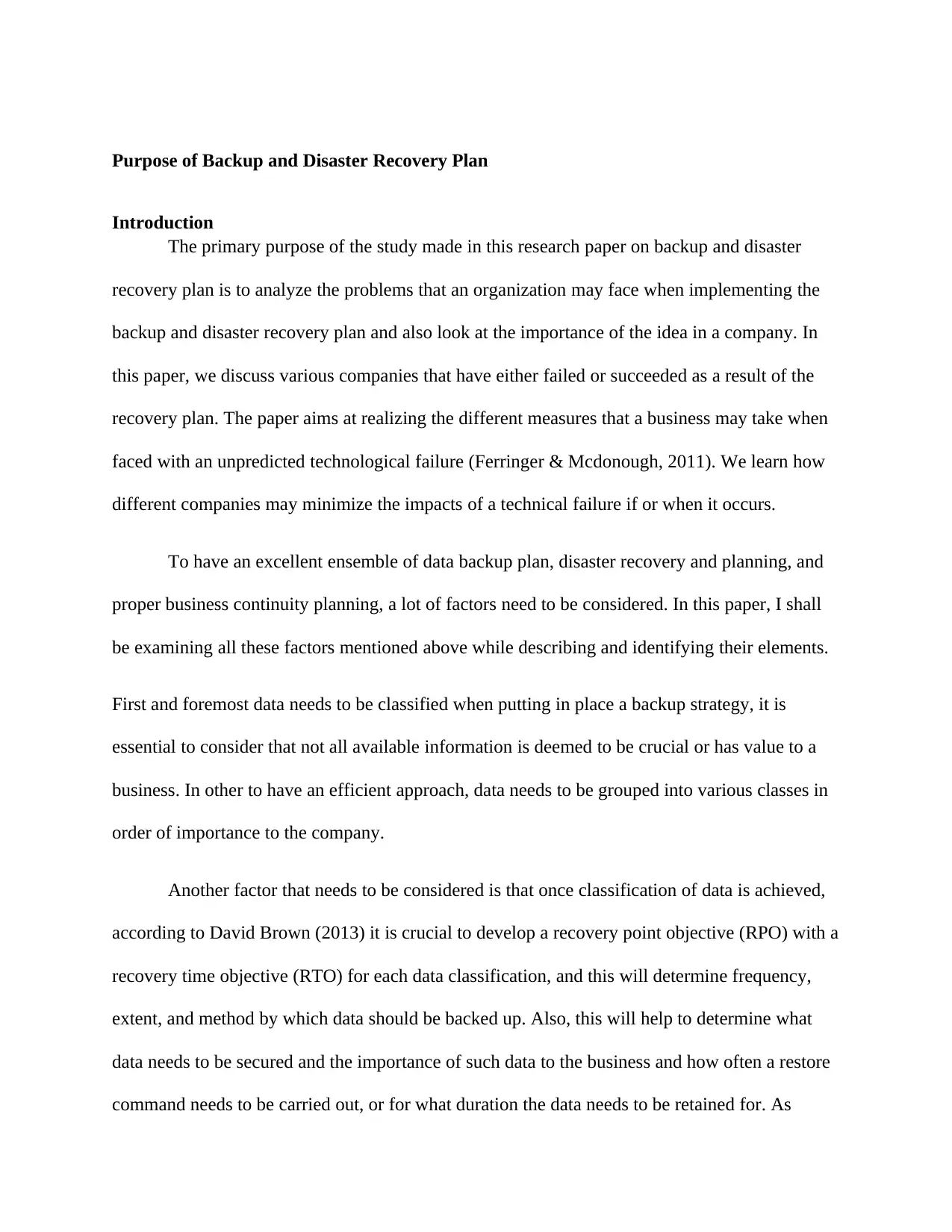
Purpose of Backup and Disaster Recovery Plan
Introduction
The primary purpose of the study made in this research paper on backup and disaster
recovery plan is to analyze the problems that an organization may face when implementing the
backup and disaster recovery plan and also look at the importance of the idea in a company. In
this paper, we discuss various companies that have either failed or succeeded as a result of the
recovery plan. The paper aims at realizing the different measures that a business may take when
faced with an unpredicted technological failure (Ferringer & Mcdonough, 2011). We learn how
different companies may minimize the impacts of a technical failure if or when it occurs.
To have an excellent ensemble of data backup plan, disaster recovery and planning, and
proper business continuity planning, a lot of factors need to be considered. In this paper, I shall
be examining all these factors mentioned above while describing and identifying their elements.
First and foremost data needs to be classified when putting in place a backup strategy, it is
essential to consider that not all available information is deemed to be crucial or has value to a
business. In other to have an efficient approach, data needs to be grouped into various classes in
order of importance to the company.
Another factor that needs to be considered is that once classification of data is achieved,
according to David Brown (2013) it is crucial to develop a recovery point objective (RPO) with a
recovery time objective (RTO) for each data classification, and this will determine frequency,
extent, and method by which data should be backed up. Also, this will help to determine what
data needs to be secured and the importance of such data to the business and how often a restore
command needs to be carried out, or for what duration the data needs to be retained for. As
Introduction
The primary purpose of the study made in this research paper on backup and disaster
recovery plan is to analyze the problems that an organization may face when implementing the
backup and disaster recovery plan and also look at the importance of the idea in a company. In
this paper, we discuss various companies that have either failed or succeeded as a result of the
recovery plan. The paper aims at realizing the different measures that a business may take when
faced with an unpredicted technological failure (Ferringer & Mcdonough, 2011). We learn how
different companies may minimize the impacts of a technical failure if or when it occurs.
To have an excellent ensemble of data backup plan, disaster recovery and planning, and
proper business continuity planning, a lot of factors need to be considered. In this paper, I shall
be examining all these factors mentioned above while describing and identifying their elements.
First and foremost data needs to be classified when putting in place a backup strategy, it is
essential to consider that not all available information is deemed to be crucial or has value to a
business. In other to have an efficient approach, data needs to be grouped into various classes in
order of importance to the company.
Another factor that needs to be considered is that once classification of data is achieved,
according to David Brown (2013) it is crucial to develop a recovery point objective (RPO) with a
recovery time objective (RTO) for each data classification, and this will determine frequency,
extent, and method by which data should be backed up. Also, this will help to determine what
data needs to be secured and the importance of such data to the business and how often a restore
command needs to be carried out, or for what duration the data needs to be retained for. As
Paraphrase This Document
Need a fresh take? Get an instant paraphrase of this document with our AI Paraphraser
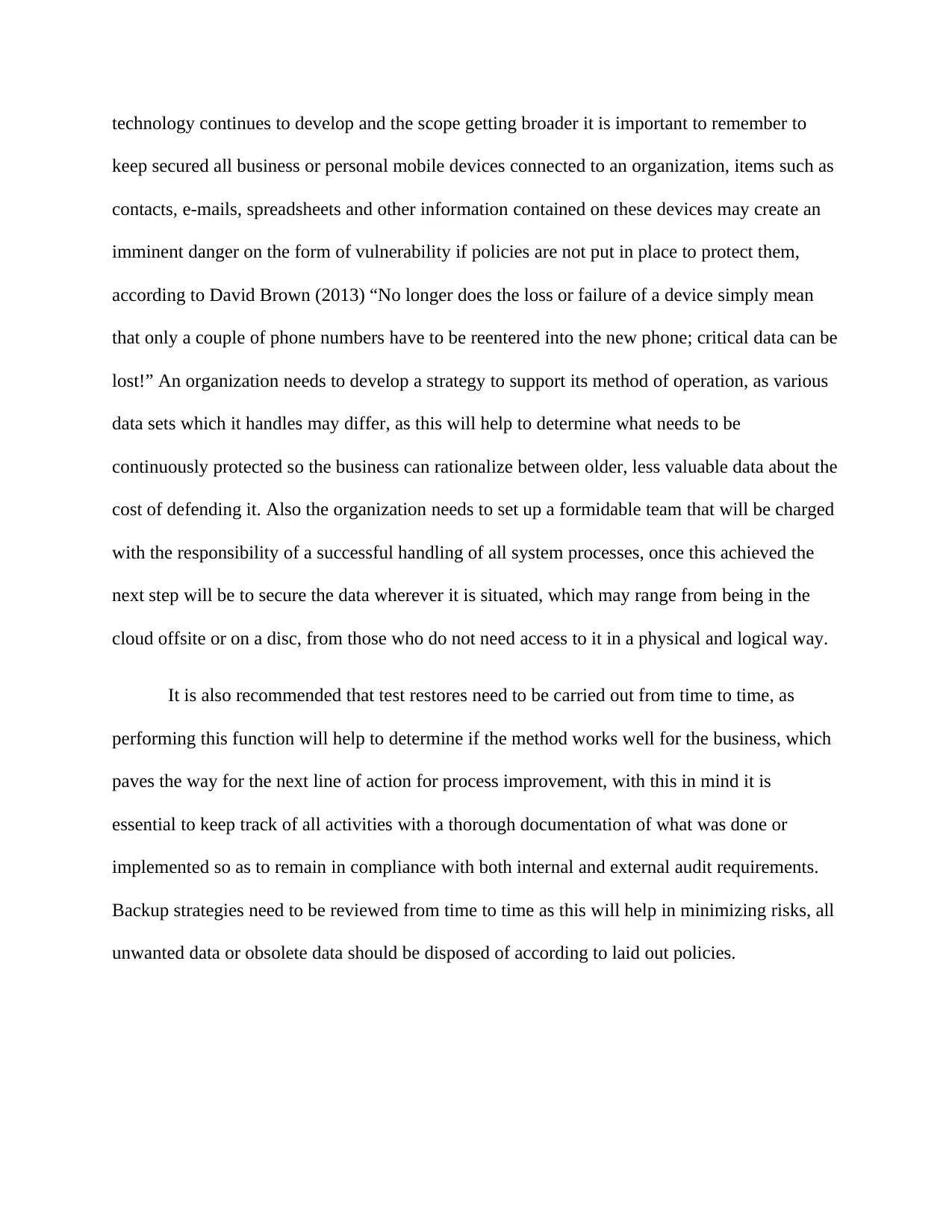
technology continues to develop and the scope getting broader it is important to remember to
keep secured all business or personal mobile devices connected to an organization, items such as
contacts, e-mails, spreadsheets and other information contained on these devices may create an
imminent danger on the form of vulnerability if policies are not put in place to protect them,
according to David Brown (2013) “No longer does the loss or failure of a device simply mean
that only a couple of phone numbers have to be reentered into the new phone; critical data can be
lost!” An organization needs to develop a strategy to support its method of operation, as various
data sets which it handles may differ, as this will help to determine what needs to be
continuously protected so the business can rationalize between older, less valuable data about the
cost of defending it. Also the organization needs to set up a formidable team that will be charged
with the responsibility of a successful handling of all system processes, once this achieved the
next step will be to secure the data wherever it is situated, which may range from being in the
cloud offsite or on a disc, from those who do not need access to it in a physical and logical way.
It is also recommended that test restores need to be carried out from time to time, as
performing this function will help to determine if the method works well for the business, which
paves the way for the next line of action for process improvement, with this in mind it is
essential to keep track of all activities with a thorough documentation of what was done or
implemented so as to remain in compliance with both internal and external audit requirements.
Backup strategies need to be reviewed from time to time as this will help in minimizing risks, all
unwanted data or obsolete data should be disposed of according to laid out policies.
keep secured all business or personal mobile devices connected to an organization, items such as
contacts, e-mails, spreadsheets and other information contained on these devices may create an
imminent danger on the form of vulnerability if policies are not put in place to protect them,
according to David Brown (2013) “No longer does the loss or failure of a device simply mean
that only a couple of phone numbers have to be reentered into the new phone; critical data can be
lost!” An organization needs to develop a strategy to support its method of operation, as various
data sets which it handles may differ, as this will help to determine what needs to be
continuously protected so the business can rationalize between older, less valuable data about the
cost of defending it. Also the organization needs to set up a formidable team that will be charged
with the responsibility of a successful handling of all system processes, once this achieved the
next step will be to secure the data wherever it is situated, which may range from being in the
cloud offsite or on a disc, from those who do not need access to it in a physical and logical way.
It is also recommended that test restores need to be carried out from time to time, as
performing this function will help to determine if the method works well for the business, which
paves the way for the next line of action for process improvement, with this in mind it is
essential to keep track of all activities with a thorough documentation of what was done or
implemented so as to remain in compliance with both internal and external audit requirements.
Backup strategies need to be reviewed from time to time as this will help in minimizing risks, all
unwanted data or obsolete data should be disposed of according to laid out policies.
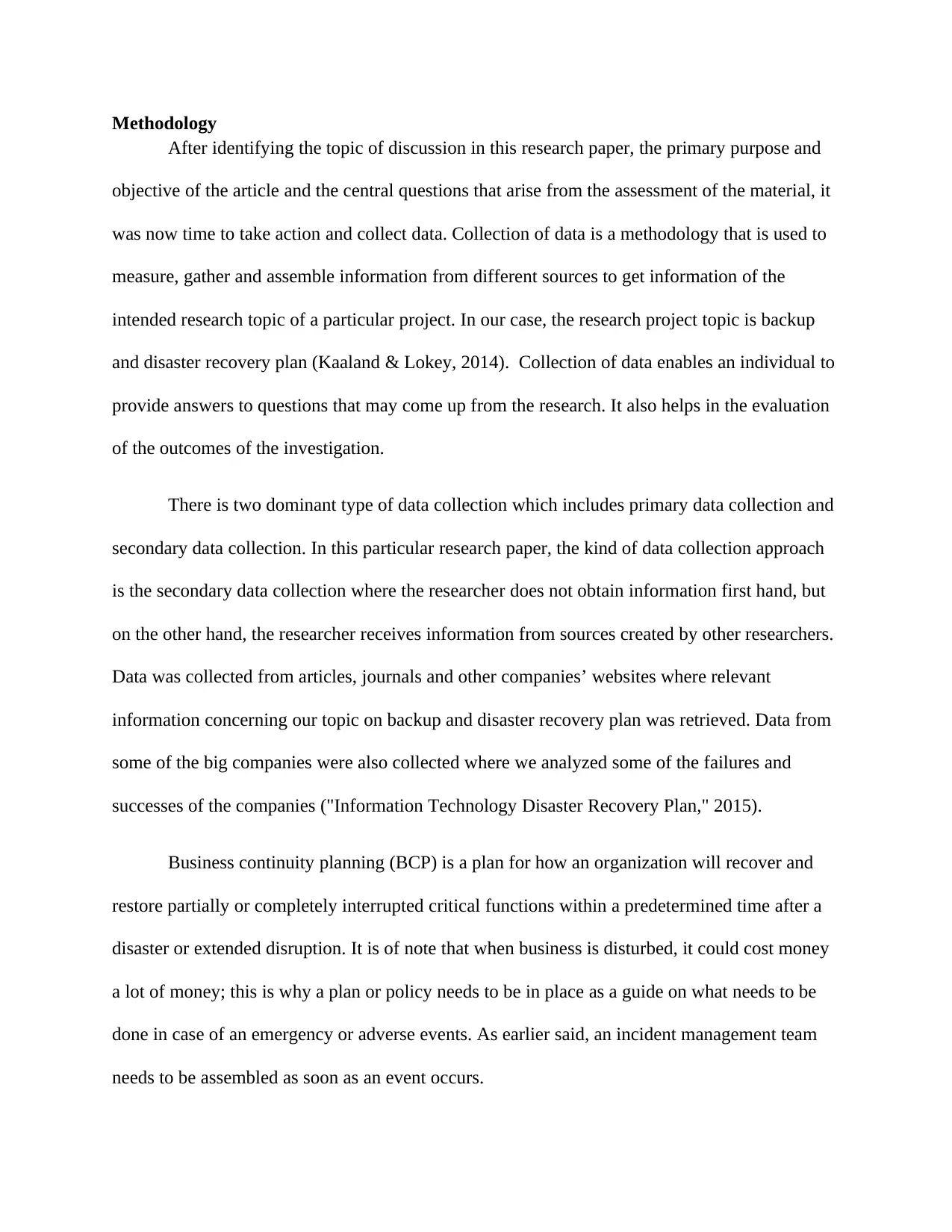
Methodology
After identifying the topic of discussion in this research paper, the primary purpose and
objective of the article and the central questions that arise from the assessment of the material, it
was now time to take action and collect data. Collection of data is a methodology that is used to
measure, gather and assemble information from different sources to get information of the
intended research topic of a particular project. In our case, the research project topic is backup
and disaster recovery plan (Kaaland & Lokey, 2014). Collection of data enables an individual to
provide answers to questions that may come up from the research. It also helps in the evaluation
of the outcomes of the investigation.
There is two dominant type of data collection which includes primary data collection and
secondary data collection. In this particular research paper, the kind of data collection approach
is the secondary data collection where the researcher does not obtain information first hand, but
on the other hand, the researcher receives information from sources created by other researchers.
Data was collected from articles, journals and other companies’ websites where relevant
information concerning our topic on backup and disaster recovery plan was retrieved. Data from
some of the big companies were also collected where we analyzed some of the failures and
successes of the companies ("Information Technology Disaster Recovery Plan," 2015).
Business continuity planning (BCP) is a plan for how an organization will recover and
restore partially or completely interrupted critical functions within a predetermined time after a
disaster or extended disruption. It is of note that when business is disturbed, it could cost money
a lot of money; this is why a plan or policy needs to be in place as a guide on what needs to be
done in case of an emergency or adverse events. As earlier said, an incident management team
needs to be assembled as soon as an event occurs.
After identifying the topic of discussion in this research paper, the primary purpose and
objective of the article and the central questions that arise from the assessment of the material, it
was now time to take action and collect data. Collection of data is a methodology that is used to
measure, gather and assemble information from different sources to get information of the
intended research topic of a particular project. In our case, the research project topic is backup
and disaster recovery plan (Kaaland & Lokey, 2014). Collection of data enables an individual to
provide answers to questions that may come up from the research. It also helps in the evaluation
of the outcomes of the investigation.
There is two dominant type of data collection which includes primary data collection and
secondary data collection. In this particular research paper, the kind of data collection approach
is the secondary data collection where the researcher does not obtain information first hand, but
on the other hand, the researcher receives information from sources created by other researchers.
Data was collected from articles, journals and other companies’ websites where relevant
information concerning our topic on backup and disaster recovery plan was retrieved. Data from
some of the big companies were also collected where we analyzed some of the failures and
successes of the companies ("Information Technology Disaster Recovery Plan," 2015).
Business continuity planning (BCP) is a plan for how an organization will recover and
restore partially or completely interrupted critical functions within a predetermined time after a
disaster or extended disruption. It is of note that when business is disturbed, it could cost money
a lot of money; this is why a plan or policy needs to be in place as a guide on what needs to be
done in case of an emergency or adverse events. As earlier said, an incident management team
needs to be assembled as soon as an event occurs.
⊘ This is a preview!⊘
Do you want full access?
Subscribe today to unlock all pages.

Trusted by 1+ million students worldwide
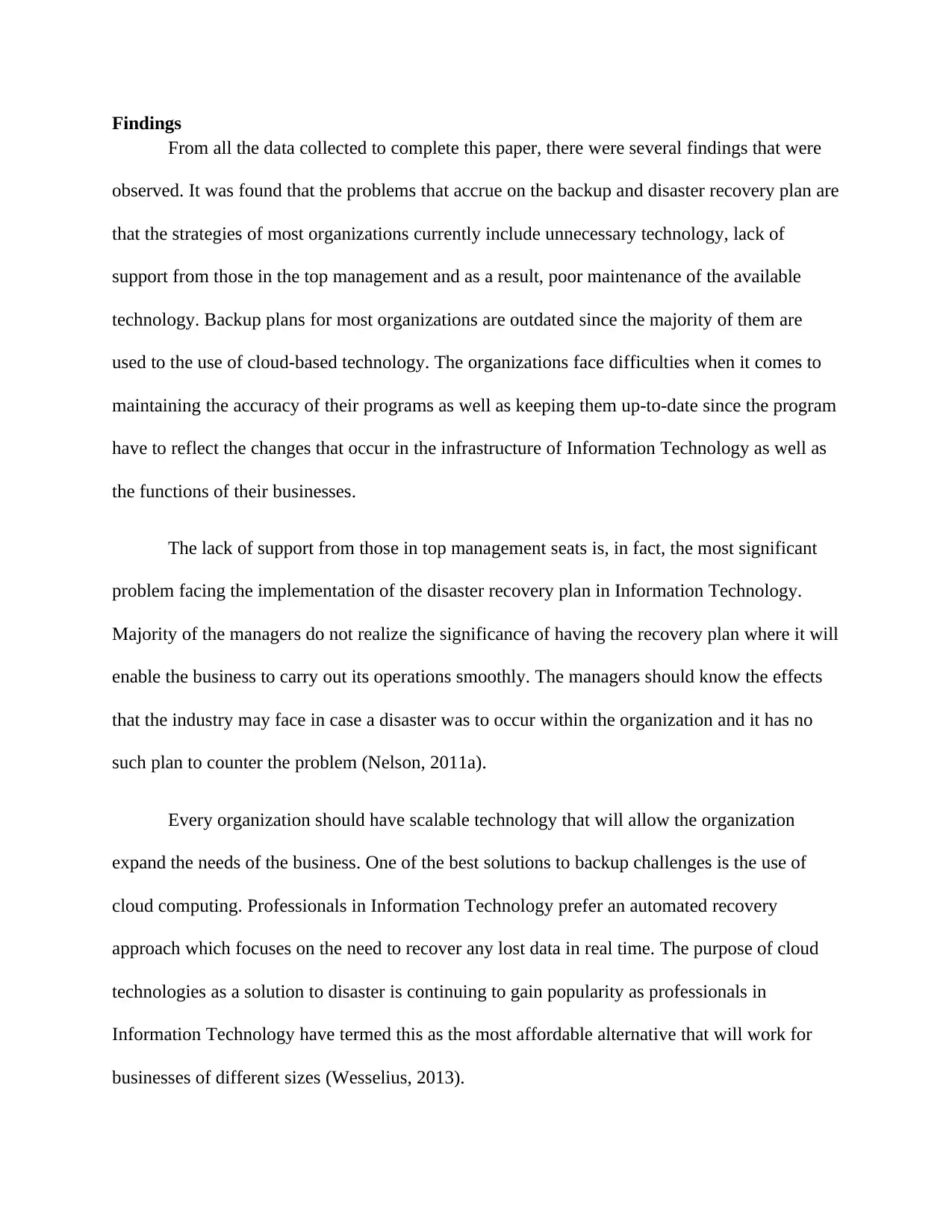
Findings
From all the data collected to complete this paper, there were several findings that were
observed. It was found that the problems that accrue on the backup and disaster recovery plan are
that the strategies of most organizations currently include unnecessary technology, lack of
support from those in the top management and as a result, poor maintenance of the available
technology. Backup plans for most organizations are outdated since the majority of them are
used to the use of cloud-based technology. The organizations face difficulties when it comes to
maintaining the accuracy of their programs as well as keeping them up-to-date since the program
have to reflect the changes that occur in the infrastructure of Information Technology as well as
the functions of their businesses.
The lack of support from those in top management seats is, in fact, the most significant
problem facing the implementation of the disaster recovery plan in Information Technology.
Majority of the managers do not realize the significance of having the recovery plan where it will
enable the business to carry out its operations smoothly. The managers should know the effects
that the industry may face in case a disaster was to occur within the organization and it has no
such plan to counter the problem (Nelson, 2011a).
Every organization should have scalable technology that will allow the organization
expand the needs of the business. One of the best solutions to backup challenges is the use of
cloud computing. Professionals in Information Technology prefer an automated recovery
approach which focuses on the need to recover any lost data in real time. The purpose of cloud
technologies as a solution to disaster is continuing to gain popularity as professionals in
Information Technology have termed this as the most affordable alternative that will work for
businesses of different sizes (Wesselius, 2013).
From all the data collected to complete this paper, there were several findings that were
observed. It was found that the problems that accrue on the backup and disaster recovery plan are
that the strategies of most organizations currently include unnecessary technology, lack of
support from those in the top management and as a result, poor maintenance of the available
technology. Backup plans for most organizations are outdated since the majority of them are
used to the use of cloud-based technology. The organizations face difficulties when it comes to
maintaining the accuracy of their programs as well as keeping them up-to-date since the program
have to reflect the changes that occur in the infrastructure of Information Technology as well as
the functions of their businesses.
The lack of support from those in top management seats is, in fact, the most significant
problem facing the implementation of the disaster recovery plan in Information Technology.
Majority of the managers do not realize the significance of having the recovery plan where it will
enable the business to carry out its operations smoothly. The managers should know the effects
that the industry may face in case a disaster was to occur within the organization and it has no
such plan to counter the problem (Nelson, 2011a).
Every organization should have scalable technology that will allow the organization
expand the needs of the business. One of the best solutions to backup challenges is the use of
cloud computing. Professionals in Information Technology prefer an automated recovery
approach which focuses on the need to recover any lost data in real time. The purpose of cloud
technologies as a solution to disaster is continuing to gain popularity as professionals in
Information Technology have termed this as the most affordable alternative that will work for
businesses of different sizes (Wesselius, 2013).
Paraphrase This Document
Need a fresh take? Get an instant paraphrase of this document with our AI Paraphraser
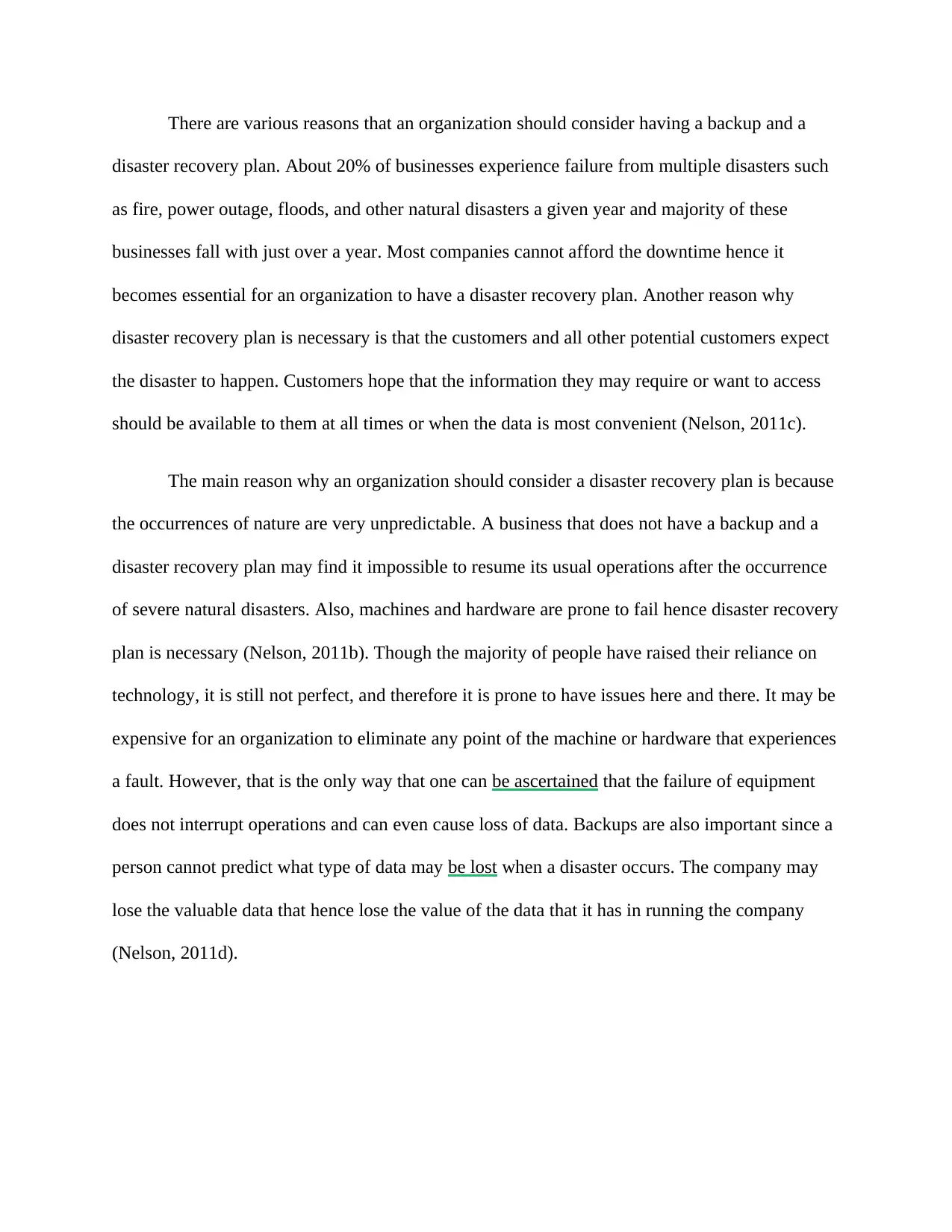
There are various reasons that an organization should consider having a backup and a
disaster recovery plan. About 20% of businesses experience failure from multiple disasters such
as fire, power outage, floods, and other natural disasters a given year and majority of these
businesses fall with just over a year. Most companies cannot afford the downtime hence it
becomes essential for an organization to have a disaster recovery plan. Another reason why
disaster recovery plan is necessary is that the customers and all other potential customers expect
the disaster to happen. Customers hope that the information they may require or want to access
should be available to them at all times or when the data is most convenient (Nelson, 2011c).
The main reason why an organization should consider a disaster recovery plan is because
the occurrences of nature are very unpredictable. A business that does not have a backup and a
disaster recovery plan may find it impossible to resume its usual operations after the occurrence
of severe natural disasters. Also, machines and hardware are prone to fail hence disaster recovery
plan is necessary (Nelson, 2011b). Though the majority of people have raised their reliance on
technology, it is still not perfect, and therefore it is prone to have issues here and there. It may be
expensive for an organization to eliminate any point of the machine or hardware that experiences
a fault. However, that is the only way that one can be ascertained that the failure of equipment
does not interrupt operations and can even cause loss of data. Backups are also important since a
person cannot predict what type of data may be lost when a disaster occurs. The company may
lose the valuable data that hence lose the value of the data that it has in running the company
(Nelson, 2011d).
disaster recovery plan. About 20% of businesses experience failure from multiple disasters such
as fire, power outage, floods, and other natural disasters a given year and majority of these
businesses fall with just over a year. Most companies cannot afford the downtime hence it
becomes essential for an organization to have a disaster recovery plan. Another reason why
disaster recovery plan is necessary is that the customers and all other potential customers expect
the disaster to happen. Customers hope that the information they may require or want to access
should be available to them at all times or when the data is most convenient (Nelson, 2011c).
The main reason why an organization should consider a disaster recovery plan is because
the occurrences of nature are very unpredictable. A business that does not have a backup and a
disaster recovery plan may find it impossible to resume its usual operations after the occurrence
of severe natural disasters. Also, machines and hardware are prone to fail hence disaster recovery
plan is necessary (Nelson, 2011b). Though the majority of people have raised their reliance on
technology, it is still not perfect, and therefore it is prone to have issues here and there. It may be
expensive for an organization to eliminate any point of the machine or hardware that experiences
a fault. However, that is the only way that one can be ascertained that the failure of equipment
does not interrupt operations and can even cause loss of data. Backups are also important since a
person cannot predict what type of data may be lost when a disaster occurs. The company may
lose the valuable data that hence lose the value of the data that it has in running the company
(Nelson, 2011d).
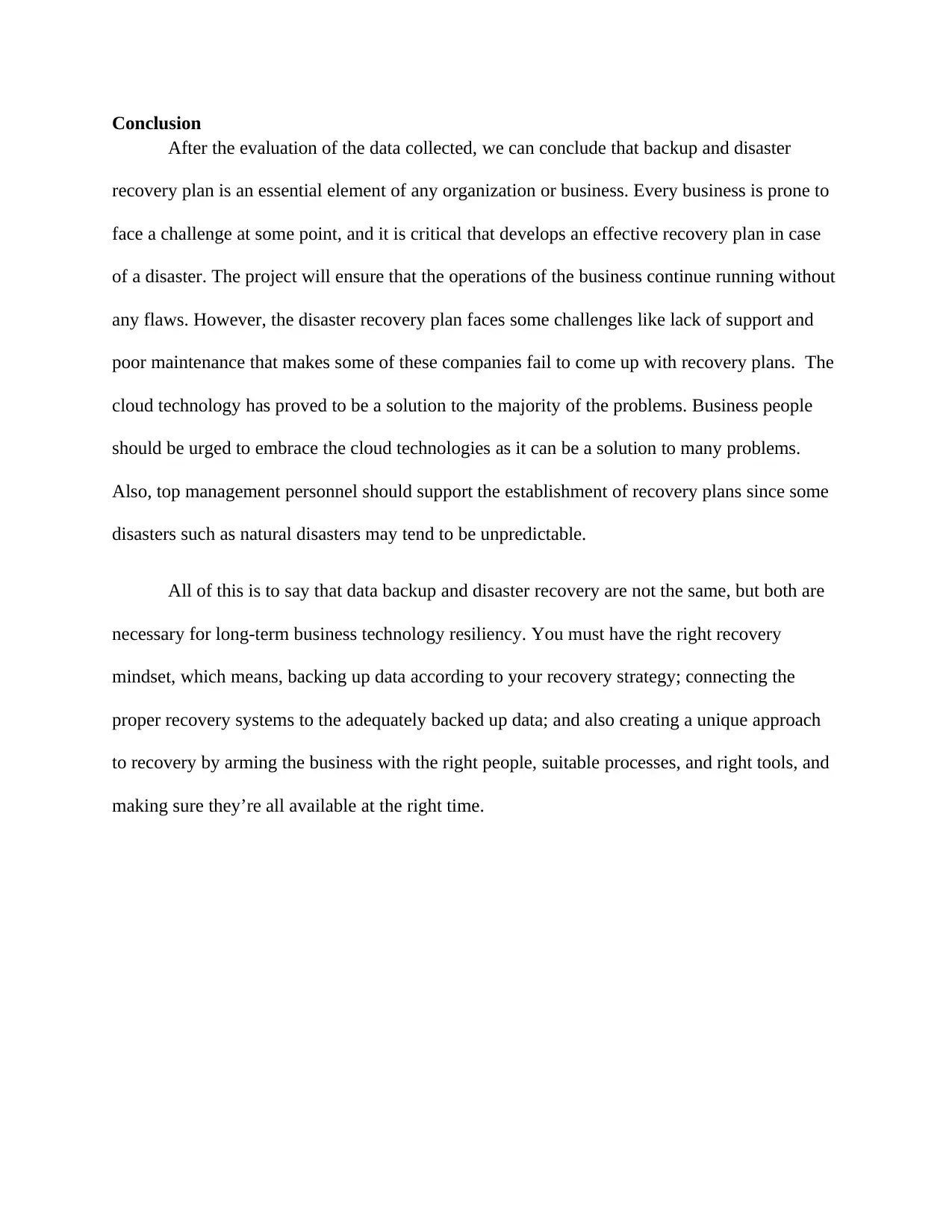
Conclusion
After the evaluation of the data collected, we can conclude that backup and disaster
recovery plan is an essential element of any organization or business. Every business is prone to
face a challenge at some point, and it is critical that develops an effective recovery plan in case
of a disaster. The project will ensure that the operations of the business continue running without
any flaws. However, the disaster recovery plan faces some challenges like lack of support and
poor maintenance that makes some of these companies fail to come up with recovery plans. The
cloud technology has proved to be a solution to the majority of the problems. Business people
should be urged to embrace the cloud technologies as it can be a solution to many problems.
Also, top management personnel should support the establishment of recovery plans since some
disasters such as natural disasters may tend to be unpredictable.
All of this is to say that data backup and disaster recovery are not the same, but both are
necessary for long-term business technology resiliency. You must have the right recovery
mindset, which means, backing up data according to your recovery strategy; connecting the
proper recovery systems to the adequately backed up data; and also creating a unique approach
to recovery by arming the business with the right people, suitable processes, and right tools, and
making sure they’re all available at the right time.
After the evaluation of the data collected, we can conclude that backup and disaster
recovery plan is an essential element of any organization or business. Every business is prone to
face a challenge at some point, and it is critical that develops an effective recovery plan in case
of a disaster. The project will ensure that the operations of the business continue running without
any flaws. However, the disaster recovery plan faces some challenges like lack of support and
poor maintenance that makes some of these companies fail to come up with recovery plans. The
cloud technology has proved to be a solution to the majority of the problems. Business people
should be urged to embrace the cloud technologies as it can be a solution to many problems.
Also, top management personnel should support the establishment of recovery plans since some
disasters such as natural disasters may tend to be unpredictable.
All of this is to say that data backup and disaster recovery are not the same, but both are
necessary for long-term business technology resiliency. You must have the right recovery
mindset, which means, backing up data according to your recovery strategy; connecting the
proper recovery systems to the adequately backed up data; and also creating a unique approach
to recovery by arming the business with the right people, suitable processes, and right tools, and
making sure they’re all available at the right time.
⊘ This is a preview!⊘
Do you want full access?
Subscribe today to unlock all pages.

Trusted by 1+ million students worldwide
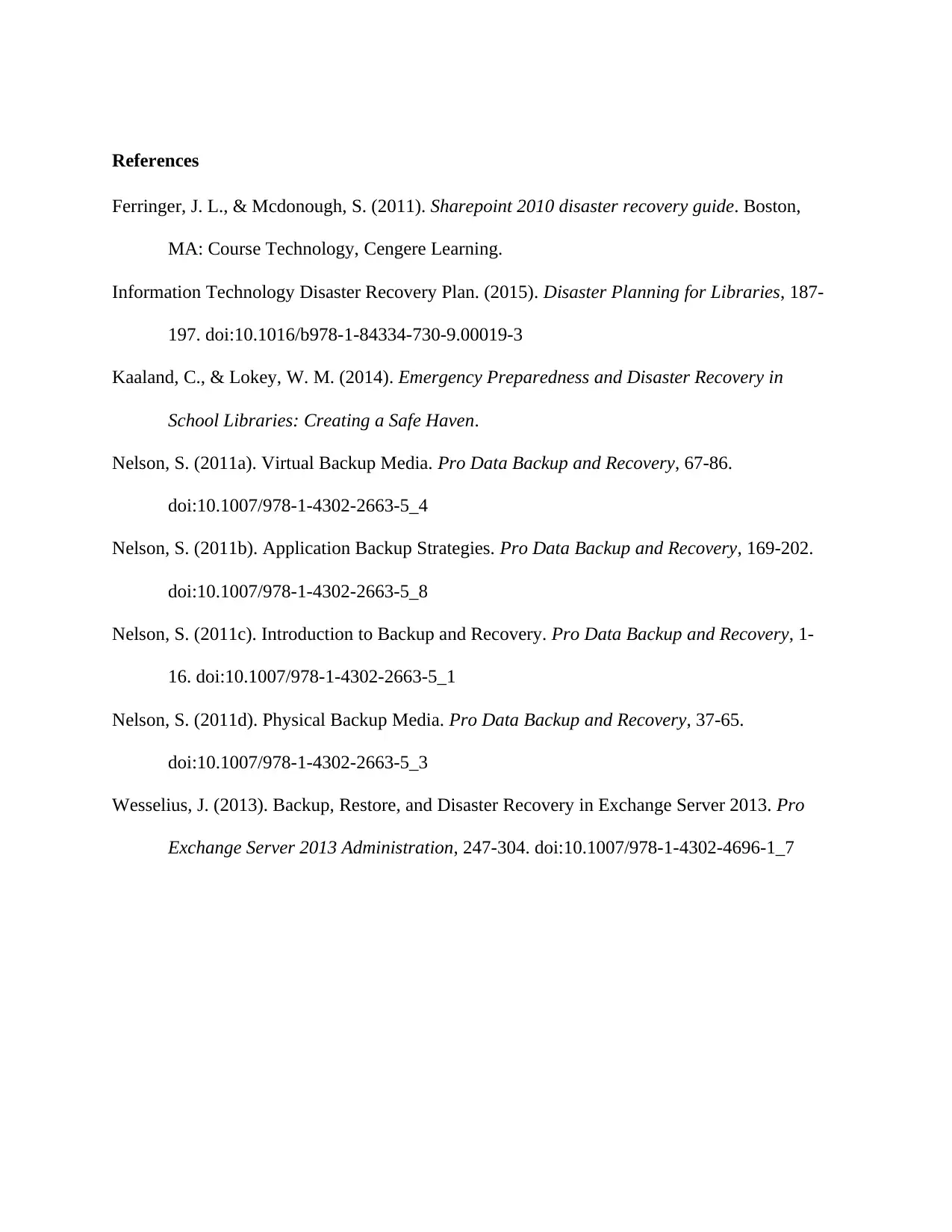
References
Ferringer, J. L., & Mcdonough, S. (2011). Sharepoint 2010 disaster recovery guide. Boston,
MA: Course Technology, Cengere Learning.
Information Technology Disaster Recovery Plan. (2015). Disaster Planning for Libraries, 187-
197. doi:10.1016/b978-1-84334-730-9.00019-3
Kaaland, C., & Lokey, W. M. (2014). Emergency Preparedness and Disaster Recovery in
School Libraries: Creating a Safe Haven.
Nelson, S. (2011a). Virtual Backup Media. Pro Data Backup and Recovery, 67-86.
doi:10.1007/978-1-4302-2663-5_4
Nelson, S. (2011b). Application Backup Strategies. Pro Data Backup and Recovery, 169-202.
doi:10.1007/978-1-4302-2663-5_8
Nelson, S. (2011c). Introduction to Backup and Recovery. Pro Data Backup and Recovery, 1-
16. doi:10.1007/978-1-4302-2663-5_1
Nelson, S. (2011d). Physical Backup Media. Pro Data Backup and Recovery, 37-65.
doi:10.1007/978-1-4302-2663-5_3
Wesselius, J. (2013). Backup, Restore, and Disaster Recovery in Exchange Server 2013. Pro
Exchange Server 2013 Administration, 247-304. doi:10.1007/978-1-4302-4696-1_7
Ferringer, J. L., & Mcdonough, S. (2011). Sharepoint 2010 disaster recovery guide. Boston,
MA: Course Technology, Cengere Learning.
Information Technology Disaster Recovery Plan. (2015). Disaster Planning for Libraries, 187-
197. doi:10.1016/b978-1-84334-730-9.00019-3
Kaaland, C., & Lokey, W. M. (2014). Emergency Preparedness and Disaster Recovery in
School Libraries: Creating a Safe Haven.
Nelson, S. (2011a). Virtual Backup Media. Pro Data Backup and Recovery, 67-86.
doi:10.1007/978-1-4302-2663-5_4
Nelson, S. (2011b). Application Backup Strategies. Pro Data Backup and Recovery, 169-202.
doi:10.1007/978-1-4302-2663-5_8
Nelson, S. (2011c). Introduction to Backup and Recovery. Pro Data Backup and Recovery, 1-
16. doi:10.1007/978-1-4302-2663-5_1
Nelson, S. (2011d). Physical Backup Media. Pro Data Backup and Recovery, 37-65.
doi:10.1007/978-1-4302-2663-5_3
Wesselius, J. (2013). Backup, Restore, and Disaster Recovery in Exchange Server 2013. Pro
Exchange Server 2013 Administration, 247-304. doi:10.1007/978-1-4302-4696-1_7
1 out of 7
Related Documents
Your All-in-One AI-Powered Toolkit for Academic Success.
+13062052269
info@desklib.com
Available 24*7 on WhatsApp / Email
![[object Object]](/_next/static/media/star-bottom.7253800d.svg)
Unlock your academic potential
Copyright © 2020–2025 A2Z Services. All Rights Reserved. Developed and managed by ZUCOL.


